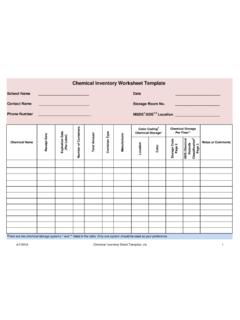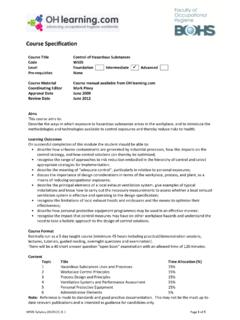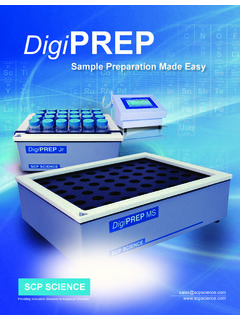Transcription of Laboratory Hoods Use and Evaluation Topics of Discussion
1 Laboratory Hoods Use and Evaluation Topics of Discussion Regulatory issues and Industry Caoimh n P. Connell Forensic Industrial Hygienist Protocols Forensic Applications, Inc. 185 Bounty Hunter Lane Bailey, CO. www. hood Classifications Evaluation methods NCAR October 29, 2010. Performance Confounders 1 2. OSHA Regulations Pertinent Standards and Protocols OSHA has extended its authority into the lab industry with 29 CFR ; The OHSA "Occupational Exposure to Hazardous NIOSH Chemicals in Laboratories" standard. This International Standards standard places several regulatory burdens on ANSI/ASHRAE laboratories including the requirement to NFPA German DIN 12 924. establish a Chemical Hygiene Plan and a AIHA British HSE DD 191 requirement that specific measures are taken to Canadian CSA: Standard ensure that fume Hoods are functioning properly ACGIH ( (e)(3)(iii)).
2 ( fume Hoods SAMA and Associated Exhaust SEFA Systems). Miscellaneous 3 4. Thoughts On hood Evaluations OSHA EPA. Although OSHA does specify minimum face velocities for Laboratory fume Hoods in several compound specific standards (29 CFR , .1004, .1007 et al), these Although the EPA has standards are not applicable to laboratories by virtue of the sponsored several research decision by the United States Court of Appeals for the Third Circuit in Synthetic Organic Chemical Manufacturer's papers in fume hood Evaluation Association v. Brennan, 506 F. 2nd 385 (3d Cir. 1974), and efficacy, there are no EPA. certiorari denied 423 830. (6) regulations concerning fume hood efficacy which are binding on US. Furthermore, in light of the current state-of-the-art industry. information on face velocities, OSHA will consider Hoods which are outside the specified minimum face velocities as de minimis violations.
3 5 6. NIOSH CDC (NIOSH)/NIH. The National Institute of The CDC pamphlet titled Occupational Safety and Health is "BIOSAFETY IN. administered by the Centers for MICROBIOLOGICAL and Disease Control, US Department BIOMEDICAL LABORATORIES". of Health and Human Services. does not provide performance NIOSH may investigate workplace exposures and report to OSHA on criteria for control devices. any deficiencies which are observed. NIOSH has no hood regulations. 7 8. Thoughts On hood Evaluations Evaluation Protocols ASHRAE. ASHRAE The ANSI/ASHRAE 110-1995 method METHOD OF TESTING. PERFORMANCE OF Laboratory fume Hoods (ISSN. 1041-2336) supersedes the ANSI/ASHRAE 110-1985. This standard is a quantitative Evaluation of hood performance ASHRAE Standard 110-1995 But: Method of Testing Performance of Laboratory fume Hoods This standard defines a reproducible method of testing Laboratory fume Hoods .
4 It does not define safe procedures.. State-of-the-art National consensus standard The procedure is a performance test method and does not constitute a performance specification. It is analogous to a method of chemical analysis, which prescribes how to analyze for The American Society of Heating, Refrigeration and Air- a chemical constituent, not how much of that substance should conditioning Engineers is a nonregulatory profit making be present. Another analogy would be a method for measuring organization. Although it publishes "standards" none of the airflow; it prescribes how the flow should be measured, not how standards are binding on businesses per se. much it should be. 9 10. ASHRAE 110 Protocol ASHRAE 110 Protocol The method consists of three parts: The method consists of three parts: 1) Flow visualization 1) Flow visualization 2) Face velocity measurements 2) Face velocity measurements 3) Tracer gas containment Evaluation 3) Tracer gas containment Evaluation The ANSI/ASHRAE method is currently the national The ANSI/ASHRAE method is currently the national consensus standard for hood performance.
5 However, consensus standard for hood performance. However, the authors of the standard were astute enough to the authors of the standard were astute enough to recognize that the standard is not a catch-all and the recognize that the standard is not a catch-all and the results of the Evaluation must be considered by an results of the Evaluation must be considered by an individual well versed in fume hood use and individual well versed in fume hood use and performance. performance. 11 12. Thoughts On hood Evaluations ASHRAE Tracer Gas Containment Test hood . TRACER GAS. SAMPLER/. DETECTOR. TRACER. GAS. CLOUD. TRACER GAS. ANALYZER. TRACER Tracer Gas Analyzer TRACER. GAS GAS. SOURCE MANNEQUIN EJECTOR. (SF6). Mannequin & Tracer Gas Detector Hitchings Associates, PC used with kind permission Hitchings Associates, PC used with kind permission The American Conference of ACGIH.
6 Governmental Industrial Hygienists ANSI/AIHA. is not regulatory governmental organization. The ACGIH is a private professional organization ANSI ( Laboratory Ventilation). which, like ASHRAE publishes recommended standards. Some ANSI Standard (Hazardous ACGIH standards may be incorporated by reference into workplace chemicals). federal, state or local codes. State of the art Some ACGIH standards may be National consensus standards incorporated by reference into federal, state or local codes 15 16. Thoughts On hood Evaluations SEFA and SAMA are furniture and apparatus manufacturer NFPA SAMA associations. As with ASHRAE, their protocols are not binding, and are not recognized by NIOSH, the NFPA 45-2011 Standard on Fire Protection for Laboratories Using Chemicals and EPA, OSHA or other organizations. They are instead an attempt to State of the art SEFA share with the general community their experience in fume Hoods in National consensus standards the spirit of disseminating information.
7 In fact, SEFA and SAMA never sought to copyright their protocol and allows anyone to photocopy or quote the material without restriction. 17 18. SAMA SEFA. (Scientific Equipment & Furniture Association). (Scientific Apparatus Makers Association). The The SEFA 1-1992 standard superseded the SAMA was an early attempt to provide guidance SAMA LF-10 1981 standard. The current SEFA. on lab fume Hoods . The SAMA LF-10-1981 (and standard is SEFA 1996. Again, the attempt subsequent) are not considered the highest to standardize the Evaluation is laudable, but the standard of care and should not be used as a sole standard should not be used as sole guidance for guidance document. hood performance Evaluation Not a copyright protected document Not a copyright protected document 19 20. Thoughts On hood Evaluations NSF IES.
8 The National Sanitation Foundation Institute of Environmental Sciences provides non-regulatory guidance and Recommended Practices (IES-RP- certification for biological safety cabinets. CC-002). The NSF standards are not binding on Primarily deals with filters US industry. National consensus standard State of the art National consensus standards State of the art 21 22. Class I Biosafety Cabinet hood Classifications Structural design dictates hood Provides glove objectives and classification. box protection for the Hoods are classified based on their employee . ultimate goal. Some Hoods protect only the item in the Hoods , some provide does not protection only for the employee. Some protect the Hoods are appropriate for biological contents contaminants, while other Hoods are inappropriate for biological contaminants.
9 23 24. Thoughts On hood Evaluations Class I Biosafety Cabinet Class III Biological Safety Cabinet Class III provides glovebox protection to the employee AND the experiment. The entire box in maintained under negative pressure.. 25 26. Class IIA Biological Safety Cabinet Class IIA Biological Safety Cabinet Alternative IIA Configuration The Class IIA. cabinet protects the employee and the experiment. The fan and plenum are contaminated and the plenum is under positive pressure. 27 28. Thoughts On hood Evaluations Class II B Biological Safety Cabinet Class IIB Biological Safety Cabinet The fan is not contaminated in the Class II B. Protection is provided to the employee and to the experiment In this version of a IIB, the plenum is maintained under negative pressure 29 30. Laminar Flow Hoods Laminar flow Hoods do not protect the employee Laboratory fume Hoods The standard Laboratory fume hood or fume cupboard is essentially a Class I Safety Cabinet.
10 It affords the employee protection, but does not protect the experiment. In its most basic design, the fume hood simply draws air through the opening and evacuates the air outside the building. The velocity of the air through the face is directly proportional to the evacuatory volume and inversely proportional to the cross sectional area of the opening of the face (called the plane of the sash). 31 32. Thoughts On hood Evaluations Single Greatest Confounder Single Greatest Confounder Reverse vector flow Reverse vector flow Negative pressure zones Poor installation Disrupted air flow Fans installed backward Supply vents Poor work practices Doors Personnel modifications Windows Labcoats Traffic Work area locations Poor design Work configurations Underrated User adjustable baffles Poor location in lab Not synced with ventilation design 33 34.




